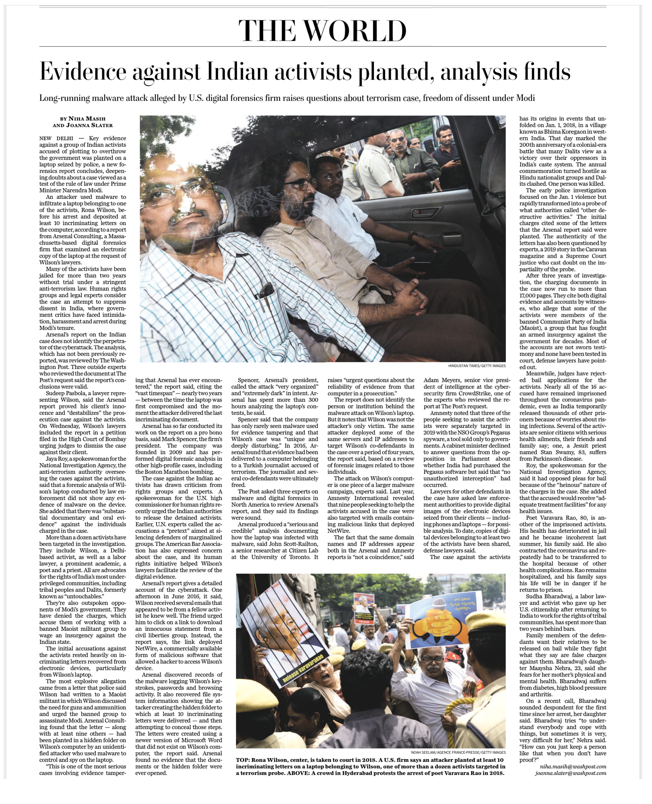For Immediate Release
As Common Notions publishes the new edition of Colors of the Cage (2021) by political prisoner and human rights activist Arun Ferreira, news is breaking that makes it abundantly clear that, just like his earlier arrests, his current detention is based on falsehood and political repression.
A Washington Post exclusive report reveals that key evidence in the Bhima Koregaon case being used to hold Arun Ferreira, Rona Wilson, Sudha Bharadwaj, Stan Swamy, Varavara Rao, and other activists in prison has been planted by malware. According to reporters Niha Masih and Joanna Slater, Arsenal Consulting, a digital forensics firm, discovered that malware was used to put incriminating letters on activist Rona Wilson’s laptop prior to his arrest.
“This is one of the most serious cases involving evidence tampering that Arsenal has ever encountered,” the report said, citing the “vast timespan”—nearly two years—between the time the laptop was first compromised and the moment the attacker delivered the last incriminating document.
This news follows appeals by numerous human rights groups and advocates including UN High Commissioner for Human Rights Michelle Bachelet, UN Special Rapporteur Prof. Mary Lawlor, the American Bar Association, and President of the Jesuit Conference Fr. Timothy P. Kesicki for the release of these activists and, in particular, the release of 83 year-old Fr. Stan Swamy who suffers from Parkinson’s disease. The Daily Beast reports, Swamy “is the oldest person to be accused of terrorism in India. To him, the arrest came as no surprise.… As a prominent human rights campaigner who has spent decades fighting for the rights of marginalized and Indigenous people (Adivasis), Swamy was the latest arrest in a sprawling 2018 case that has seen 16 human rights activists accused of being in league with the CPI (Maoist).”
Judges have not responded to these appeals and have rejected bail applications for the activists—even as thousands of prisoners have been released due to fears of COVID outbreaks. Fortunately, Fr. Swamy writes that his care is being provided by co-accused prisoners Arun Ferreira, Varavara Rao, and Vernon Gonsalves, who are being held in an adjacent cell, and by his cellmates:
“During the day, when cells and barracks are opened, we meet with each other. From 5:30pm to 6:00am and 12 noon to 3:00pm, I am locked up in my cell, with two inmates. Arun assists me to have my breakfast and lunch. Vernon helps me with bath. My two inmates help out during supper, in washing my clothes and give massage to my knee joints. They are from very poor families. Please remember my inmates and my colleagues in your prayers. Despite all odds, humanity is bubbling in Taloja prison.”
This solidarity among prisoners is something that Ferreira returns to again and again in Colors of the Cage.
In fact, this solidarity is able to transcend prison walls. For example, in December 2020, on World Farmer’s Day Ferreira and his co-accused engaged in a hunger strike in support of protesting farmers’ demands that the Indian government repeal new laws that would deregulate agricultural markets and consequently devastate their livelihoods. As Ferreira writes of another hunger strike in Colors of the Cage, “Like the poor of our country, we had limited choice regarding the form of our protest.”
Colors of the Cage introduces Arun Ferreira to many who may not be familiar with him. In his introduction to the new edition Sidhartha Deb writes, “Ferreira’s subjection to torture and incarceration, however, was provoked by no more than a sense of injustice at the state of the world. A middle-class Catholic fired by liberation theology and Marxism as a student, his life as he describes it before incarceration consists of organizing in support of the deprived, invisible majority of India—villagers, slumdwellers, peoples of the Northeast and Kashmir. His unforgivable crime was to be opposed to both the neoliberal project opening up India for foreign capital as well as to India’s national project of subjugating everyone different from the Hindu elite.”
In May 2007, Arun Ferreira was picked up at a railway station in western India, detained by the court, and condemned to prison for an expanding list of crimes: criminal conspiracy, murder, possession of arms, and rioting, among others added during his detention. In one of the most notorious prisons in India, he was constantly abused and tortured. Over the next several years as he began to write Colors of the Cage, each of the ten cases slapped against him fell apart. At long last, acquitted of all charges, he prepared to reunite with his family. As he exited the prison, moments away from freedom, he was rearrested by plainclothes police. He never got to glimpse his family waiting for him just outside the prison gates.
Ferreira refused to surrender hope and continued to fight for his freedom. He succeeded and walked out of the prison in 2014 and then used his prison experience to become a lawyer for other political activists. In 2018, he was arrested once again in what is shaping up to be a major frame up. His next hearing is February 28th. As he continues to fight for justice, his memoir and his life are timely reminders that across the globe policing and incarceration are institutions in desperate need of being dismantled.
Order Colors of the Cage in paperback or ebook
Follow Arun Ferreira’s case at Front Line Defenders



